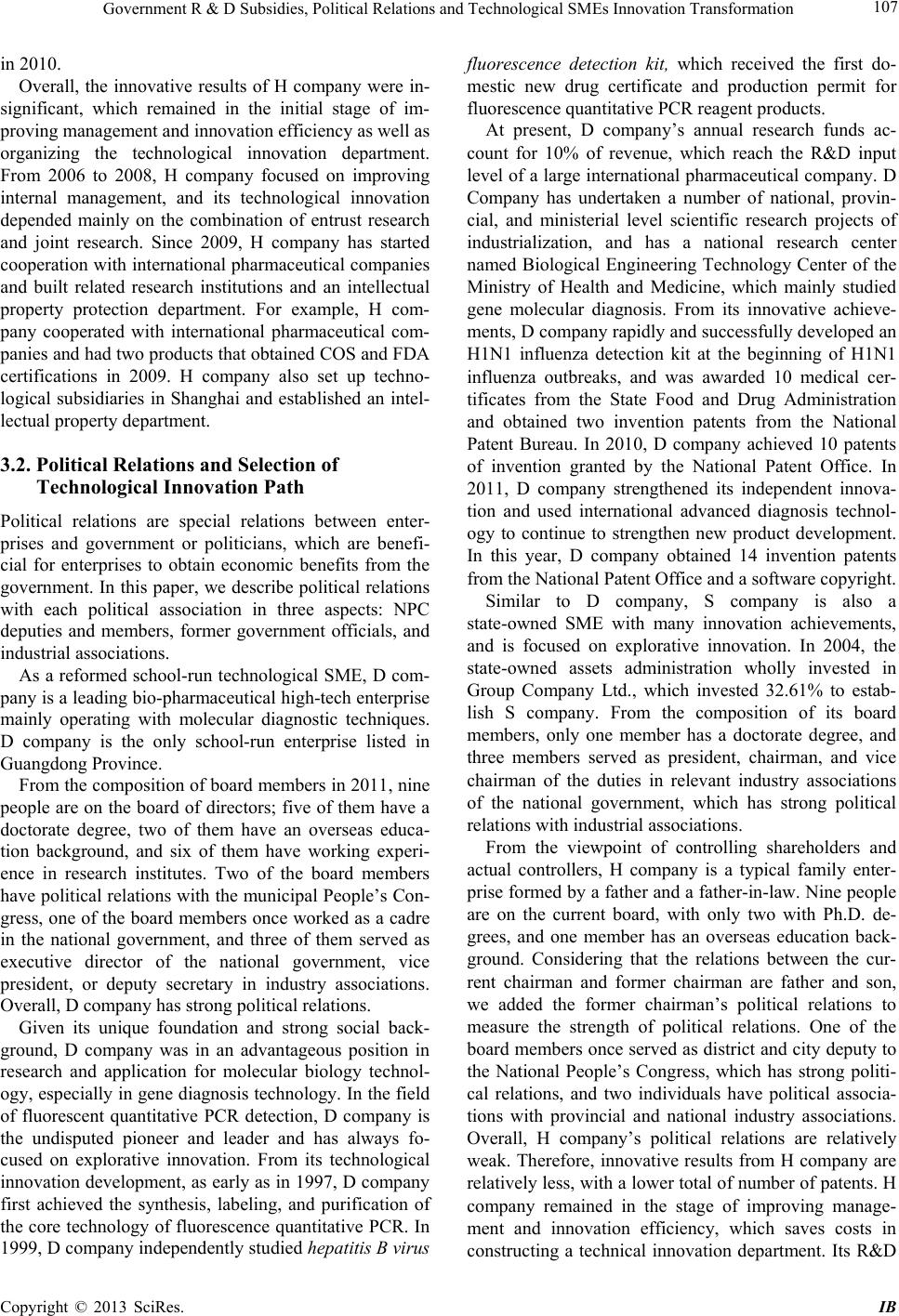
Government R & D Subsidies, Political Relations and Technological SMEs Innovation Transformation 107
in 2010.
Overall, the innovative results of H company were in-
significant, which remained in the initial stage of im-
proving management and innovation efficiency as well as
organizing the technological innovation department.
From 2006 to 2008, H company focused on improving
internal management, and its technological innovation
depended mainly on the combination of entrust research
and joint research. Since 2009, H company has started
cooperation with international pharmaceutical companies
and built related research institutions and an intellectual
property protection department. For example, H com-
pany cooperated with international pharmaceutical com-
panies and had two products that obtained COS and FDA
certifications in 2009. H company also set up techno-
logical subsidiaries in Shanghai and established an intel-
lectual property department.
3.2. Political Relations and Selection of
Technological Innovation Path
Political relations are special relations between enter-
prises and government or politicians, which are benefi-
cial for enterprises to obtain economic benefits from the
government. In this paper, we describe political relations
with each political association in three aspects: NPC
deputies and members, former government officials, and
industrial associations.
As a reformed school-run technological SME, D com-
pany is a leading bio-pharmaceutical high-tech enterprise
mainly operating with molecular diagnostic techniques.
D company is the only school-run enterprise listed in
Guangdong Province.
From the composition of board members in 2011, nine
people are on the board of directors; five of them have a
doctorate degree, two of them have an overseas educa-
tion background, and six of them have working experi-
ence in research institutes. Two of the board members
have political relations with the municipa l People’s Con-
gress, one of the board members once worked as a cadre
in the national government, and three of them served as
executive director of the national government, vice
president, or deputy secretary in industry associations.
Overall, D company has strong political relations.
Given its unique foundation and strong social back-
ground, D company was in an advantageous position in
research and application for molecular biology technol-
ogy, especially in gen e diagnosis technology. In the field
of fluorescent quantitative PCR detection, D company is
the undisputed pioneer and leader and has always fo-
cused on explorative innovation. From its technological
innovation develop ment, as early as in 1997, D company
first achieved the synthesis, labeling, and purification of
the core technology of fluorescence quantitative PCR. In
1999, D company independently studied hepatitis B virus
fluorescence detection kit, which received the first do-
mestic new drug certificate and production permit for
fluorescence quantitative PCR reagent products.
At present, D company’s annual research funds ac-
count for 10% of revenue, which reach the R&D input
level of a large international pharmaceutical company. D
Company has undertaken a number of national, provin-
cial, and ministerial level scientific research projects of
industrialization, and has a national research center
named Biological Engineering Technology Center of the
Ministry of Health and Medicine, which mainly studied
gene molecular diagnosis. From its innovative achieve-
ments, D company rapidly and successfully developed an
H1N1 influenza detection kit at the beginning of H1N1
influenza outbreaks, and was awarded 10 medical cer-
tificates from the State Food and Drug Administration
and obtained two invention patents from the National
Patent Bureau. In 2010, D company achieved 10 patents
of invention granted by the National Patent Office. In
2011, D company strengthened its independent innova-
tion and used international advanced diagnosis technol-
ogy to continue to strengthen new product development.
In this year, D company obtained 14 invention patents
from the National Patent Office and a software copyright.
Similar to D company, S company is also a
state-owned SME with many innovation achievements,
and is focused on explorative innovation. In 2004, the
state-owned assets administration wholly invested in
Group Company Ltd., which invested 32.61% to estab-
lish S company. From the composition of its board
members, only one member has a doctorate degree, and
three members served as president, chairman, and vice
chairman of the duties in relevant industry associations
of the national government, which has strong political
relations with industrial associatio ns.
From the viewpoint of controlling shareholders and
actual controllers, H company is a typical family enter-
prise formed by a father and a father-in-law. Nine people
are on the current board, with only two with Ph.D. de-
grees, and one member has an overseas education back-
ground. Considering that the relations between the cur-
rent chairman and former chairman are father and son,
we added the former chairman’s political relations to
measure the strength of political relations. One of the
board members once served as district and city deputy to
the National People’s Congress, which has strong politi-
cal relations, and two individuals have political associa-
tions with provincial and national industry associations.
Overall, H company’s political relations are relatively
weak. Therefore, innovative results from H company are
relatively less, with a lower total of number of patents. H
company remained in the stage of improving manage-
ment and innovation efficiency, which saves costs in
constructing a technical innovation department. Its R&D
Copyright © 2013 SciRes. IB